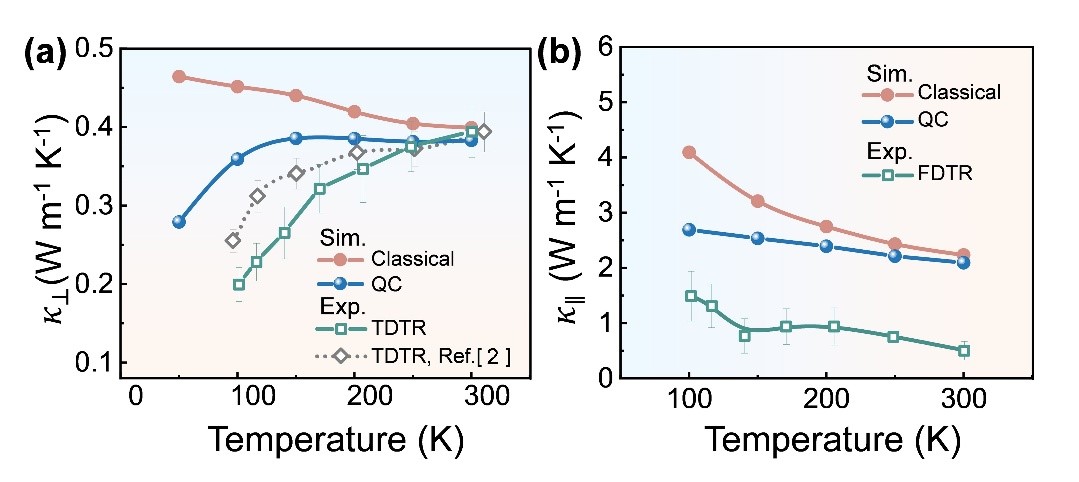Researchers make breakthrough in magnetic geometry-induced quantum geometry and nonlinear transport
2025-06-06SUSTech hosts IOP Forum with President of Institute of Physics Sir Keith Burnett
2025-03-26Researchers discover unusual thermal conductivity in high-symmetry single crystals
2025-03-26New efficient method detects quantum temporal correlations
2025-03-26Researchers explore unconventional magnons predicted by spin space groups
2025-03-25Single crystals exhibiting glass-like thermal conductivity are exceptionally rare because of the fundamentally different heat conduction mechanisms and atomic structures between crystals and glasses. Typically, above the Debye temperature, the thermal conductivities of crystals decrease with increasing temperature until they asymptotically approach a lower limit. In contrast, the thermal conductivities of amorphous materials increase with rising temperature due to their lack of long-range order.

Chair Professor Jiaqing He’s research group from the Department of Physics at the Southern University of Science and Technology (SUSTech) has challenged the traditional understanding of condensed matter physics. They have reported significant findings on the thermal conductivity properties of high-symmetry single-crystal BaTiS3.
Their study, titled “Strong Orbital-Lattice Coupling Induces Glassy Thermal Conductivity in High-Symmetry Single Crystal BaTiS3”, has been published in Physical Review X.
Despite its long-range ordered atomic arrangement, BaTiS3 exhibits both amorphous (in-plane) and crystalline (out-of-plane) thermal transport performance. The team revealed that strong orbital-lattice coupling in BaTiS3 leads to spontaneous symmetry breaking, resulting in the formation of a unique 1D order-2D disorder lattice structure. This novel microscopic structure leads to atypical thermal transport properties that diverge from conventional crystals.

Figure 1. (a) Chain-like atomic structure of BaTiS3 with space group P63/mmc; (b) Phonon dispersion of BaTiS3 showing imaginary phonon modes; Structure of the BaTiS3 supercell after structure relaxation, viewed along the (c) [100] and (d) [001] directions; (e) Selected-area electron diffraction patterns of the single crystal BaTiS3, with the simulated results shown in the inset; (f) Electron energy-loss spectroscopy (EELS) of Ti-L2,3 edge (open circle)
BaTiS3 adopts a high-symmetry average hexagonal perovskite structure (space group P63/mmc, point group D6h), where Ti-centered octahedra, coordinated by S atoms, share common faces to form anti-prismatic chain-like structures along the c-axis (Figure 1a). The research group calculated the phonon dispersion (Figure 1b), revealing significant structural instability in BaTiS3. When the ideal TiS6 octahedra undergoes structural distortions, the electron cloud distribution between Ti and S atoms rearranges, enhancing the overlap of Ti and S atomic orbitals. This change in orbital overlap further triggers a decrease in the total energy of the system, which acts as a driving force for spontaneous distortions in the Ti-S octahedra.
Theoretical calculations suggest that this orbital-lattice coupling effect ultimately leads to a unique crystal structure characterized by intrachain order and interchain disorder (Figures 1c-d). To confirm this, the researchers used selected area electron diffraction (SAED) to visually verify the “1D order + 2D disorder” structure in BaTiS3 crystals, providing solid experimental evidence to support earlier theoretical predictions. Furthermore, through electron energy loss spectroscopy (EELS) analysis, they accurately measured that the Ti atoms exhibit a Ti3+ valence state (Figure 1f). According to the crystal field theory, the anti-prismatic Ti-S octahedra complex formed two sets of d orbitals, namely, the high-energy, two-fold degenerate eg orbitals (dz2 and dx2+y2), and low-energy, three-fold degenerate t2g orbitals (dxy, dyz, and dxz). A single d electron in the Ti3+ ions randomly occupying one of the t2g orbitals, spontaneously transformed the three-fold degenerate state into a non-degenerate state through symmetry breaking, resulting in a distorted structure.

Figure 2. (a) The in-plane thermal conductivity, predicted by molecular dynamics simulations with classical and quantum-corrected heat capacity as well as experiment values measured by TDTR; (b) The crystal-like out-of-plane thermal conductivity as predicted by MD simulation and measured by FDTR experiments
Professor He’s group utilized the neuroevolution potential (NEP) to train the interatomic potential of BaTiS3 and applied homogeneous nonequilibrium molecular dynamics (HNEMD) to predict the in-plane and out-of-plane thermal conductivities of BaTiS3 (Figure 2). They successfully grew BaTiS3 single crystals using the vapor transport method, measuring their in-plane and out-of-plane thermal conductivities using experimental thermal measurement techniques such as time-domain thermoreflectance (TDTR) and frequency-domain thermoreflectance (FDTR). Their results indicate that both the theoretically predicted and experimentally measured in-plane thermal conductivities exhibit a trend similar to amorphous materials, increasing with temperature. In contrast, the out-of-plane thermal conductivities show the typical behavior of crystalline materials, decreasing as the temperature rises.
This study demonstrated the impact of strong orbital-lattice coupling effects on crystal structure and thermal conductivity in theoretical predictions and experimental measurements. Their findings are significant for explaining local disorder and anomalous thermal transport phenomena in high-symmetry crystals, providing innovative approaches to optimizing and discovering new, high-performance thermoelectric materials.
Ph.D. students Yan Wang from SUSTech and Haobo Yang from Huazhong University of Science and Technology (HUST), along with Associate Professor Lin Xie from the Greater Bay University, are the co-first authors of this paper. Additional contributors include Research Assistant Professor Mingyuan Hu from SUSTech, Professor Xin Qian from HUST, and Professor Ronggui Yang from Peking University. Chair Professor Jiaqing He and Associate Professor Lin Xie are the corresponding authors, with SUSTech as the first affiliated institution.
Paper link: